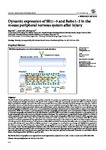Dynamic expression of Slit1–3 and Robo1–2 in the mouse peripheral nervous system after injury
| dc.contributor.author | Chen, B | |
| dc.contributor.author | Carr, L | |
| dc.contributor.author | Zhang, He | |
| dc.date.accessioned | 2019-12-03T16:10:55Z | |
| dc.date.available | 2019-12-03T16:10:55Z | |
| dc.date.issued | 2020 | |
| dc.identifier.issn | 1673-5374 | |
| dc.identifier.issn | 1876-7958 | |
| dc.identifier.uri | http://hdl.handle.net/10026.1/15221 | |
| dc.description.abstract |
The Slit family of axon guidance cues act as repulsive molecules for precise axon pathfinding and neuronal migration during nervous system development through interactions with specific Robo receptors. Although we previously reported that Slit1-3 and their receptors Robo1 and Robo2 are highly expressed in the adult mouse peripheral nervous system, how this expression changes after injury has not been well studied. Herein, we constructed a peripheral nerve injury mouse model by transecting the right sciatic nerve. At 14 days after injury, quantitative real-time polymerase chain reaction was used to detect mRNA expression of Slit1-3 and Robo1-2 in L4-5 spinal cord and dorsal root ganglia, as well as the sciatic nerve. Immunohistochemical analysis was performed to examine Slit1-3, Robo1-2, neurofilament heavy chain, F4/80, and vimentin in L4-5 spinal cord, L4 dorsal root ganglia, and the sciatic nerve. Co-expression of Slit1-3 and Robo1-2 in L4 dorsal root ganglia was detected by in situ hybridization. In addition, Slit1-3 and Robo1-2 protein expression in L4-5 spinal cord, L4 dorsal root ganglia, and sciatic nerve were detected by western blot assay. The results showed no significant changes of Slit1-3 or Robo1-2 mRNA expression in the spinal cord within 14 days after injury. In the dorsal root ganglion, Slit1-3 and Robo1-2 mRNA expression were initially downregulated within 4 days after injury; however, Robo1-2 mRNA expression returned to the control level, while Slit1-3 mRNA expression remained upregulated during regeneration from 4-14 days after injury. In the sciatic nerve, Slit1-3 and their receptors Robo1-2 were all expressed in the proximal nerve stump; however, Slit1, Slit2, and Robo2 were barely detectable in the nerve bridge and distal nerve stump within 14 days after injury. Slit3 was highly ex-pressed in macrophages surrounding the nerve bridge and slightly downregulated in the distal nerve stump within 14 days after injury. Robo1 was upregulated in vimentin-positive cells and migrating Schwann cells inside the nerve bridge. Robo1 was also upregulated in Schwann cells of the distal nerve stump within 14 days after injury. Our findings indicate that Slit3 is the major ligand expressed in the nerve bridge and distal nerve stump during peripheral nerve regeneration, and Slit3/Robo signaling could play a key role in peripheral nerve repair after injury. This study was approved by Plymouth University Animal Welfare Ethical Review Board (approval No. 30/3203) on April 12, 2014. | |
| dc.format.extent | 948-948 | |
| dc.format.medium | ||
| dc.language | en | |
| dc.language.iso | en | |
| dc.publisher | Medknow | |
| dc.rights | Attribution-NonCommercial-NoDerivatives 4.0 International | |
| dc.rights | Attribution-NonCommercial-NoDerivatives 4.0 International | |
| dc.rights | Attribution-NonCommercial-NoDerivatives 4.0 International | |
| dc.rights | Attribution-NonCommercial-NoDerivatives 4.0 International | |
| dc.rights | Attribution-NonCommercial-NoDerivatives 4.0 International | |
| dc.rights | Attribution-NonCommercial-NoDerivatives 4.0 International | |
| dc.rights | Attribution-NonCommercial-NoDerivatives 4.0 International | |
| dc.rights | Attribution-NonCommercial-NoDerivatives 4.0 International | |
| dc.rights | Attribution-NonCommercial-NoDerivatives 4.0 International | |
| dc.rights.uri | http://creativecommons.org/licenses/by-nc-nd/4.0/ | |
| dc.rights.uri | http://creativecommons.org/licenses/by-nc-nd/4.0/ | |
| dc.rights.uri | http://creativecommons.org/licenses/by-nc-nd/4.0/ | |
| dc.rights.uri | http://creativecommons.org/licenses/by-nc-nd/4.0/ | |
| dc.rights.uri | http://creativecommons.org/licenses/by-nc-nd/4.0/ | |
| dc.rights.uri | http://creativecommons.org/licenses/by-nc-nd/4.0/ | |
| dc.rights.uri | http://creativecommons.org/licenses/by-nc-nd/4.0/ | |
| dc.rights.uri | http://creativecommons.org/licenses/by-nc-nd/4.0/ | |
| dc.rights.uri | http://creativecommons.org/licenses/by-nc-nd/4.0/ | |
| dc.subject | Robo 1 | |
| dc.subject | Robo 2 | |
| dc.subject | Slit1 | |
| dc.subject | Slit2 | |
| dc.subject | Slit3 | |
| dc.subject | dorsal root ganglion | |
| dc.subject | nerve regeneration | |
| dc.subject | neural regeneration | |
| dc.subject | peripheral nerve | |
| dc.subject | sciatic nerve | |
| dc.title | Dynamic expression of Slit1–3 and Robo1–2 in the mouse peripheral nervous system after injury | |
| dc.type | journal-article | |
| dc.type | Journal Article | |
| plymouth.author-url | https://www.ncbi.nlm.nih.gov/pubmed/31719262 | |
| plymouth.issue | 5 | |
| plymouth.volume | 15 | |
| plymouth.publication-status | Published | |
| plymouth.journal | Neural Regeneration Research | |
| dc.identifier.doi | 10.4103/1673-5374.268930 | |
| plymouth.organisational-group | /Plymouth | |
| plymouth.organisational-group | /Plymouth/Faculty of Health | |
| plymouth.organisational-group | /Plymouth/REF 2021 Researchers by UoA | |
| plymouth.organisational-group | /Plymouth/REF 2021 Researchers by UoA/UoA03 Allied Health Professions, Dentistry, Nursing and Pharmacy | |
| plymouth.organisational-group | /Plymouth/Research Groups | |
| plymouth.organisational-group | /Plymouth/Research Groups/Institute of Translational and Stratified Medicine (ITSMED) | |
| plymouth.organisational-group | /Plymouth/Research Groups/Institute of Translational and Stratified Medicine (ITSMED)/CBR | |
| dc.publisher.place | India | |
| dcterms.dateAccepted | 2019-06-10 | |
| dc.rights.embargodate | 2019-12-6 | |
| dc.identifier.eissn | 1876-7958 | |
| dc.rights.embargoperiod | Not known | |
| rioxxterms.versionofrecord | 10.4103/1673-5374.268930 | |
| rioxxterms.licenseref.uri | http://creativecommons.org/licenses/by-nc-nd/4.0/ | |
| rioxxterms.type | Journal Article/Review |



